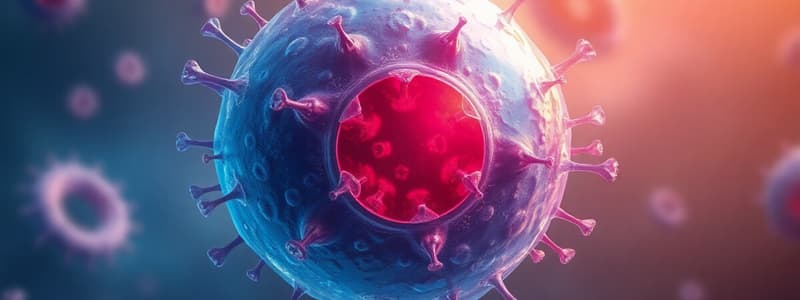Podcast
Questions and Answers
What is the concept of adaptation in cells?
What is the concept of adaptation in cells?
Reversible changes in the cells in response to changes in their environment.
Which of the following is a type of cell adaptation?
Which of the following is a type of cell adaptation?
- Atrophy
- Hyperplasia
- Hypertrophy
- All of the above (correct)
What is hypertension's role in myocardial muscle fibers?
What is hypertension's role in myocardial muscle fibers?
It can lead to hypertrophy of myocardial muscle fibers.
Apoptosis is the same as necrosis.
Apoptosis is the same as necrosis.
What is hyperplasia?
What is hyperplasia?
What triggers atrophy in cells?
What triggers atrophy in cells?
Metaplasia is an irreversible change in cells.
Metaplasia is an irreversible change in cells.
What is a common cause of endometrial hyperplasia?
What is a common cause of endometrial hyperplasia?
Hypertrophy occurs when there is an increase in the size of cells without creating new cells, often due to _____.
Hypertrophy occurs when there is an increase in the size of cells without creating new cells, often due to _____.
Match the types of cell adaptations with their definitions:
Match the types of cell adaptations with their definitions:
Flashcards are hidden until you start studying
Study Notes
Cell Adaptation
- Adaptation is a reversible change in cells in response to environmental changes.
- Cells can recover to their original state when the stress is eliminated.
Hypertrophy
- Increase in the size of cells, resulting in an increased size of the organ.
- Occurs due to increased production of structural proteins and organelles.
- Can occur alongside hyperplasia, leading to an enlarged organ.
- Physiological hypertrophy: Muscle hypertrophy in bodybuilders due to increased workload. Enlargement of the uterus during pregnancy due to estrogen.
- Pathological hypertrophy: Myocardial muscle fiber hypertrophy due to hypertension.
Hyperplasia
- Increase in the number of cells in an organ or tissue, usually resulting in increased mass.
- Occurs in cells capable of replication.
- Physiological hyperplasia: Proliferation of glandular epithelium in the female breast during puberty and pregnancy. Restoration of liver size after partial resection.
- Pathological hyperplasia: Endometrial hyperplasia due to increased estrogen levels, leading to abnormal menstrual bleeding. Benign prostatic hyperplasia induced by androgens.
Atrophy
- Shrinkage of cells by loss of cell substance.
- Affects entire tissue or organ when a sufficient number of cells are involved.
- Atrophic cells are not dead, but have diminished function.
- Caused by decreased protein synthesis and increased protein degradation.
- Causes:
- Decreased workload (disuse atrophy): Skeletal muscle atrophy due to immobilization.
- Loss of innervation (denervation atrophy): Nerve damage.
- Diminished blood supply (ischemia): Brain atrophy in elderly due to reduced blood supply.
- Inadequate nutrition: Skeletal muscle used as an energy source.
- Loss of endocrine stimulation: Endometrial atrophy due to hormone loss after menopause.
- Aging (senile atrophy):
Metaplasia
- Reversible change where one adult cell type is replaced by another adult cell type.
- Occurs when cells sensitive to stress are replaced by cells more resistant to the environment.
- Represents a genetic reprogramming of stem cells, not a change in already differentiated cells.
- Protective mechanisms are lost in metaplastic cells.
- Persistent influences increase the risk of malignant transformation.
Types of Metaplasia
- Epithelial metaplasia:
- Squamous metaplasia: Columnar epithelial cells replaced by squamous cells, for example, in the trachea and bronchi of smokers due to cigarette smoke.
- Mesenchymal metaplasia:
- Bone formation in soft tissue due to injury.
- Conversion of connective tissue to bone (Ossification) due to trauma, inflammation, or tumor growth.
Studying That Suits You
Use AI to generate personalized quizzes and flashcards to suit your learning preferences.




